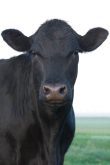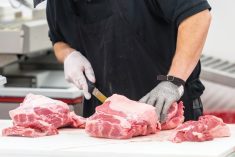The U. S. Agriculture Department is trying to speed the development of an H1N1 flu vaccine for hogs by providing two master seed viruses to five veterinary vaccine makers, Agriculture Secretary Tom Vilsack said Sept. 10.
The new pandemic flu strain, a mix of human, avian and swine vi ruses of ten referred to as “swine flu,” has infected and killed people around the world, but has not yet been found in U. S. hogs, Vilsack said.
“Our hope is that (manufacturers) will take this seed virus and they will refine it and work with it and finalize it to the point where they actually get a vaccine which they then can produce,” Vilsack said.
Read Also

Pig transport stress costs pork sector
Popular livestock trailer designs also increase pig stress during transportation, hitting at meat quality, animal welfare and farm profit, Agriculture and Agri-Food Canada researcher says
“We’re not there yet.”
The USDA master seed virus is virus material that can be used to make a vaccine to prevent hogs from catching H1N1. USDA chief veterinarian John Clifford told reporters the department hoped “to have vaccine available, if needed, sometime this calendar year.”
Swine flu, common in hogs around the world, causes fever and coughing in pigs, which usually recover from the illness.
The airborne virus can pass back and forth between people and pigs, although such transmission is uncommon.
The virus has been found in several herds in Canada.
“This fall, it’s possible that we’ll find the influenza in swine,” Vilsack said, noting USDA would step up its surveillance efforts.
The USDA launched a pilot project this year to look for new strains of flu in pigs.
An official with the World Organizat ion for Animal Health said in June it will be difficult to boost surveillance of hogs for the H1N1 flu unless farmers are confident they won’t be penalized if the disease is found in their barns. There also is concern that trading partners could block U. S. exports.
USDA disagreed and said farmers have incentive to send healthy pigs to slaughter.
“If they send ill animals to slaughter we can adjust the production rate and when that happens they get a downgrade for the price they’re going to receive for those hogs,” said Kenneth Petersen, assistant administrator with USDA’s Food Safety and Inspection Service.
“There is just no incentive to do anything other than their best to send young, healthy swine to slaughter.”
Scient ists say pigs can act as “mixing vessels” for viruses, and believe the new H1N1 virus was circulating undetected for years, most likely in pigs.
If the USDA finds the virus in hogs, it will work with state governments, farmers and veterinarians to prevent its spread, Vilsack said.
Only hogs that have fully recovered from the flu will be allowed to be slaughtered for food, he said, stressing that consumers cannot catch the airborne virus from eating pork.


















